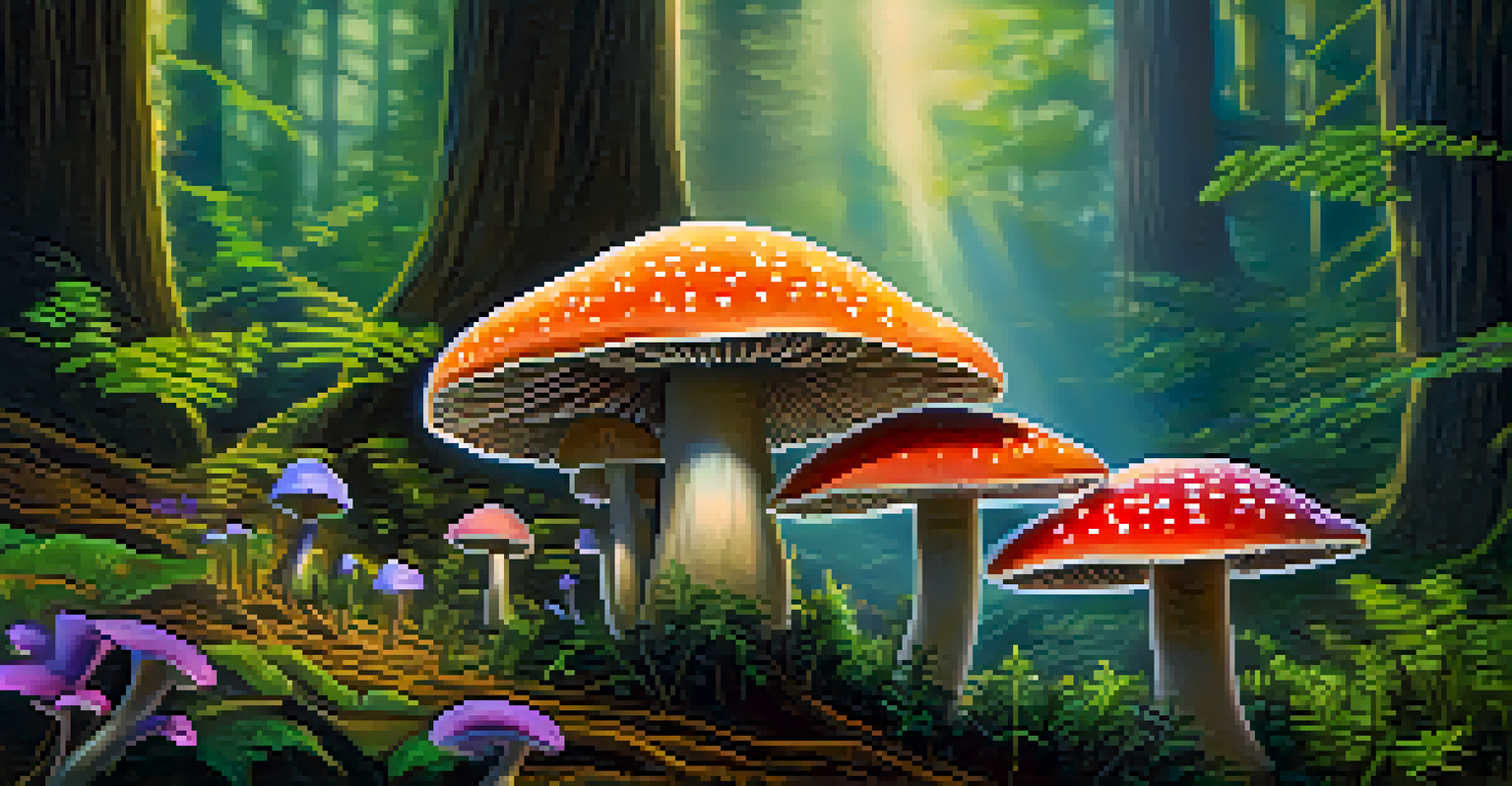Sacred Plants: The Role of Nature in Altered States

Understanding Altered States of Consciousness
Altered states of consciousness (ASC) refer to a range of mental states that differ from our normal waking consciousness. These states can be induced through various means, such as meditation, sleep deprivation, or the use of sacred plants. Each of these methods provides unique experiences, but the fascinating aspect is how nature plays a pivotal role, particularly through plants that have been used for centuries in spiritual practices.
The greatest discovery of my generation is that a human being can alter his life by altering his attitude.
Sacred plants are often intertwined with cultural rituals, offering users a pathway to connect with deeper aspects of themselves or the universe. For instance, indigenous tribes have long utilized these plants in ceremonies to seek guidance, healing, or enlightenment. This blend of nature and spirituality creates a rich tapestry of experiences that can lead to profound personal insights.
Moreover, the physiological effects of these plants can significantly alter our perception of reality. When consumed, they may interact with the brain's neurotransmitter systems, creating a unique experience that can range from heightened awareness to deep introspection. Understanding these changes can help us appreciate the depth of human experience and the powerful role nature plays in it.
The Significance of Sacred Plants in Cultures
Throughout history, various cultures have revered sacred plants for their spiritual significance. From the Peyote cactus in Native American rituals to the Ayahuasca brew in the Amazon, these plants serve as conduits for deeper understanding and connection with the divine. They are not merely substances; they are seen as teachers that offer wisdom and guidance.

In many traditions, these plants are used in a communal setting, fostering a sense of belonging and shared experience. Participants often describe feeling a deep connection not only to each other but also to the world around them. This communal aspect is crucial as it amplifies the effects of the plants, creating a layered experience that transcends individual consciousness.
Sacred Plants and Spiritual Connection
Sacred plants play a vital role in various cultures, serving as conduits for deeper understanding and connection to the divine.
Furthermore, the use of sacred plants often involves a guided experience, where shamans or spiritual leaders help navigate the altered state. This guidance can be essential in ensuring safety and maximizing the potential benefits of the experience. By respecting the traditions surrounding these plants, individuals can engage in a meaningful exploration of their consciousness.
Popular Sacred Plants and Their Effects
Some of the most well-known sacred plants include Psilocybin mushrooms, Ayahuasca, and Peyote. Each offers unique effects and experiences, often described as transformative. For example, Psilocybin mushrooms can evoke vivid visual hallucinations and a profound sense of interconnectedness, leading to insights about life and existence.
Nature does not hurry, yet everything is accomplished.
Ayahuasca, on the other hand, is known for its purgative effects and deep emotional healing properties. Participants often report experiencing their past traumas, leading to cathartic releases and greater emotional clarity. This dual nature of both physical and emotional processing makes Ayahuasca a powerful tool for personal growth.
Peyote provides a different experience, often characterized by introspection and spiritual connection. Users may find themselves reflecting on their life choices and relationships, leading to a renewed sense of purpose. The diversity of experiences offered by these sacred plants showcases the wide-ranging effects nature can have on our consciousness.
The Science Behind Sacred Plants and ASCs
Scientific research into the effects of sacred plants is gaining momentum, revealing fascinating insights into how they influence altered states of consciousness. Studies have shown that compounds like Psilocybin can promote neuroplasticity, which is the brain's ability to reorganize itself by forming new neural connections. This suggests that these experiences can lead to lasting changes in perception and behavior.
Moreover, the effects of these plants are not solely psychological; they also have profound physiological impacts. For instance, Ayahuasca contains DMT, a compound that interacts with serotonin receptors in the brain, leading to altered sensory perceptions. This scientific understanding helps bridge the gap between ancient practices and modern neuroscience, highlighting the importance of these plants in our understanding of consciousness.
Therapeutic Potential of Sacred Plants
Recent research highlights the potential therapeutic benefits of sacred plants like Psilocybin and Ayahuasca in mental health treatment.
As research continues, the potential therapeutic benefits of these sacred plants are becoming clearer. From treating depression and anxiety to enhancing creativity and problem-solving, the implications are vast. This growing body of evidence underscores the significant role nature plays in shaping our mental health and overall well-being.
Modern Applications of Sacred Plants
In recent years, there has been a resurgence of interest in sacred plants, particularly in therapeutic settings. Many mental health professionals are exploring the use of substances like Psilocybin and Ayahuasca as adjuncts to traditional therapies. This shift towards integrating these ancient practices into modern medicine reflects a growing recognition of their potential benefits.
Retreats and workshops centered around sacred plant experiences have also gained popularity. These settings provide individuals a safe and supportive environment to explore their consciousness. Participants often leave these experiences with newfound clarity and insights, helping them navigate personal challenges and growth.
However, this modern application comes with responsibilities. It is crucial to approach these experiences with respect and understanding of the traditions from which they originate. By honoring the cultural significance of these plants, we can ensure that their use in contemporary settings remains respectful and beneficial.
Challenges and Ethical Considerations
As interest in sacred plants grows, so do concerns about their ethical use. The commercialization of these substances can lead to exploitation, particularly of indigenous cultures that have traditionally used them in spiritual practices. It's essential to recognize the origins of these plants and the cultural contexts in which they thrive.
Moreover, not everyone is suited for experiences with sacred plants. Individuals with certain mental health conditions may face risks when engaging with these substances. Therefore, proper screening and guidance are vital to ensure safety and well-being during these transformative experiences.
Ethical Considerations in Usage
The growing interest in sacred plants raises important ethical concerns about their commercialization and the need for respectful engagement with indigenous cultures.
Navigating the line between exploration and exploitation requires a commitment to ethical practices. Engaging with indigenous communities, respecting their traditions, and prioritizing responsible use can help ensure that the sacred plants maintain their integrity while offering their wisdom to a broader audience.
The Future of Sacred Plants in Society
The future of sacred plants in our society appears promising, as more people seek alternative methods for healing and self-discovery. As the stigma surrounding their use diminishes, we can expect a more open dialogue about their benefits and potential applications. This could lead to increased acceptance and integration into mainstream wellness practices.
Furthermore, ongoing research will likely continue to unveil the therapeutic properties of these plants, fostering a greater understanding of their role in mental health care. As evidence mounts, we may see policy changes that allow for regulated, safe access to sacred plants, making them more widely available to those in need.

Ultimately, the conversation surrounding sacred plants is evolving, highlighting the importance of nature in our quest for understanding consciousness. By embracing these natural allies, we can foster a deeper connection to ourselves and the world around us, paving the way for a more holistic approach to well-being.